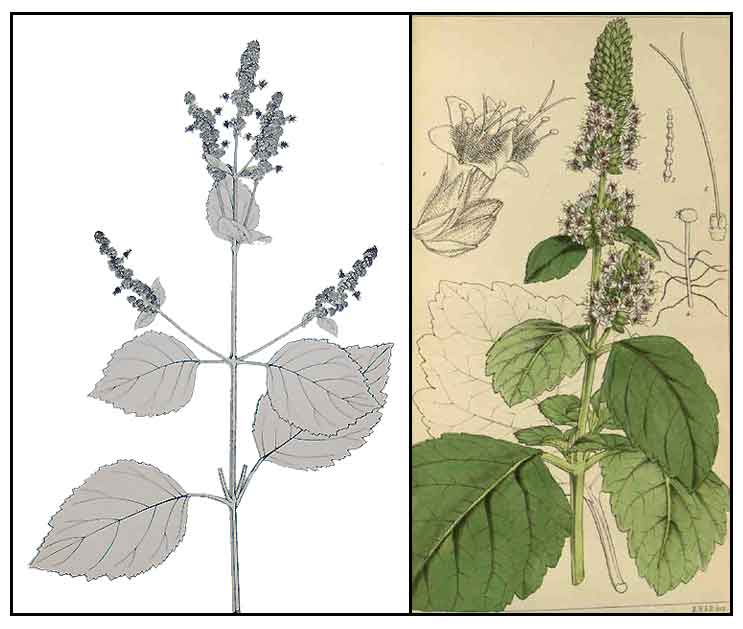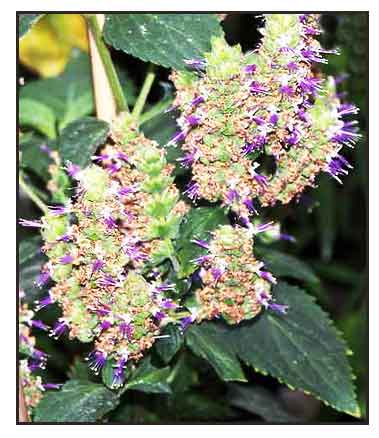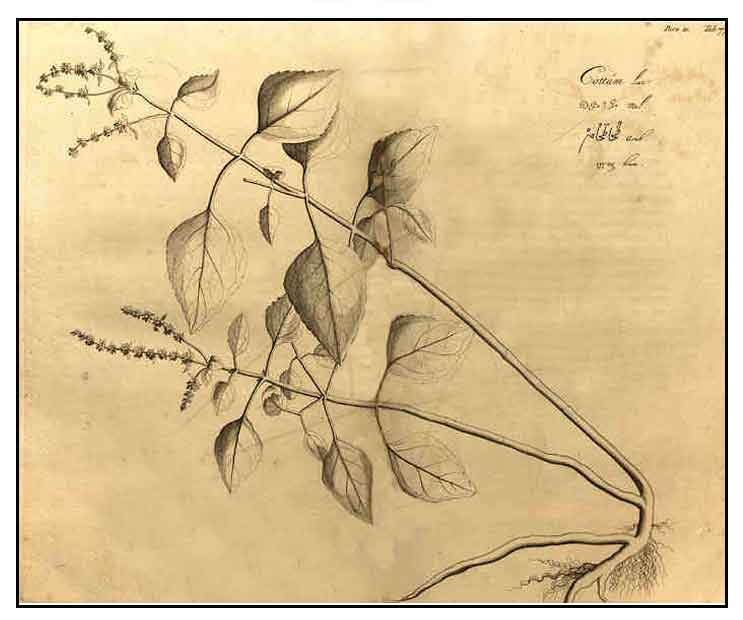
Gen info
- Etymology: Patchouli oil may have derived from the Hindi word "pacholi," meaning "to scent." Or, it may have derived from the ancient Tamil words "patchai" and "ellai," meaning "green leaf."
-
There are three species of Patchouli, Pogostemon cablin, P. heyneanus, and P. hortensis. Of These, the most popular is P. cablin, the one most cultivated for its essential oil, which is considered superior to others.
- While widespread in popularity i the 60s, Patchouli oil was used centuries ago. Highly values, European traders exchanged it for gold, pound for pound.
- "King Tut"--Pharaoh Tutankhamun, was buried with 10 gallons of it.
-- In the 1800s, it was used to scent Indian fabrics such as fine silks and shawls to rid them of moths and other insects. (21)
- The essential oil extracted from leaves of P. cablin has the highest potential for use in the perfume industry.
(21)
Botany
Kabling is an aromatic, erect,
branched and hairy herb, growing to a height of 0.5 to 1 meter.
Leaves are oblong-ovate to ovate, 5 to 11 centimeters long, with coarse
and doubly-toothed margins, and with a blunt or pointed tip. Flowers are
pinkish-purple, crowded and borne in hairy, terminal, axillary
spikes 2 to 8 centimeters long, 1 to 1.5 centimeters in diameter. Calyx is about 6 millimeters long. Corolla is 8 millimeters long, with obtuse lobes.
 Distribution Distribution
- Found in Cagayan, Bontoc, Rizal, Pampanga and Camarines Provinces in Luzon; and in Leyte, occasionally planted in gardens, and occurring also on steep talus slopes in areas remote from settlements.
- Generally cultivated in tropical Asia and Malaya.
Constituents
- Leaves yield a volatile
oil, 6-10%.
- Patchouli oil contains patchouli alcohol Patchouli camphor), cadinene, coerulein, benzaldehyde and
eugenol.
- Important components of the essential oil are patchoulol and norpatchoulenol.
- Study of essential oil yielded 11 compounds, including α- and ß-patchoulene, patchouli alcohol (patchoulol), ß-caryophyllene, α-guaiene, seychellene and selinene.
(9)
- GC-MS hydrodistillation study of leaves for essential oil on yielded
22 compounds with18 sesquiterpenes and three oxygenated sesquiterpenes. Among these patchouli alcohol (60.30 %) was the major component, followed by germacrene A (11.73 %). (7)
- Study of aerial parts yielded 13 compounds: patchouli alcohol (1), pogostone (2), friedelin (3), epifriedelinol (4), oleanolic acid (5), methyl oleanolate (6), 5alpha-stigmast-3,6-dione (7), stigmast-4-ene-3-one (8), beta-sitosterol (9), pachypodol (10), retusin (11), (-)-guaiacylglycerol (12) and dibutyl phthalate (13).
(16)
-Study of leaves, a water extract showed highest total phenolic content with 116.88 ± 0.48 mg GAE/g dry plant extract. An ethanolic extract yielded highest total flavonoid content with 280.12 ± 2.04 mg QE/ g dry plant extract. (see study below) (18)
- GC-FID and GC-MS studies evaluated leaves, inflorescence, whole aerial parts
and root of patchouli for essential oils. Altogether 34 constituents were identified representing 86.9-97.7% of the total oil compositions. Major constituent of oil from aerial parts (leaves, inflorescence, and whole aerial parts) were patchouli alcohol (42.2–57.7%), α-bulnesene (9.0–15.2%), α-guaiene (6.4–17.9%), seychellene (3.4–6.9%), pogostol (0.3–5.0%) and (E)-caryophyllene (2.1–3.6%). the root oil yielded higher amount of pogostone (70.2%), norpatchoulenol (5.3%) and β-pinene (4.5%). (19)
- In a study evaluating the major sesquiterpenes in essential oil of three different parts (leaves, stems, and roots), GCMA analysis yielded 12 sesquiterpenes. Patchouli alcohol (37.54%-51.02% in leaves, 28.24-41.96% in stems, and 14.55%-35.12% i roots) was the major sesquiterpene during maturation o f the plant. Other sesquiterpenes (α-bulnesene, α-guaiene, seychellene, ß-humulene, and yophyllene) were higher than 3% among leaves, stems, and roots. (23)
- Activity guided study of acetone extract of P. cablin isolated three new sesquiterpene hydroperoxides (1-3), with known sesquiterpene, patchouli alcohol (3). (see study below) (30)
Properties
- Antibacterial, antifungal, diuretic, carminative, insecticidal, stimulant, and emmenagogue.
- The oil may have antibactericidal activity and pogostone may have antibacterial
and antifungal activities.
- Components eugenol, cinnamaldehyde and benzaldehyde have insecticidal
activity.
- Studies have shown antioxidant, mosquito repellent, anti-inflammatory, antimutagenic, analgesic, anti-platelet aggregation properties.
Parts
used
Leaves, flowering
spikes, roots.
 Uses Uses
Edibility
- Oil used as ingredient in foods and beverages.
Folkloric
- In the Philippines, leaves and tops are used as insecticide - as a repellent of cockroaches, moths, ants, etc.
-
For arthritis and rheumatism, crushed leaves are applied on affected parts.
- Infusion of fresh leaves for given for dysmenorrhea; also as emmenagogue.
Infusion of leaves, dried tops or roots used for scanty urination.
- Leaves and tops employed in baths; used for antirheumatic action.
- In India, infusion of leaves, flowering spikes or dried tops and root used as diuretic and carminative; used with Ocimum sanctum for scanty urine and biliousness. This infusion is reported to occasionally cause loss of appetite and sleep, and nervous attacks.
- In Malaysia and Japan,
has been used as antidote for venomous snake and insect bites.
- In traditional Chinese
medicine, used for colds, fever, headaches, nausea, vomiting, diarrhea and
abdominal pain, to stimulate the appetite.
- In Uruguay, infusion of leaves used for nervous troubles; roots considered stimulant.
- In traditional Asian folk medicine, patchouli oil used for the treatment of dandruff, skin irritation and dryness, acne, and eczema.
(21)
Others
- Repellent: Leaves and tops used
as insecticide repellent for cockroaches, moths, ants, etc. Juice of leaves rubbed on hands and feet for climbing mountains to repel leeches (limatiks).
- Hair: Leaves used with gogo for washing hair. Also, used as hair conditioner for dreadlocks.
- Smoking: In India, used as ingredient in tobacco smoking.
- Patchoui oil / Fragrant scent: Patchouli fragrant oil is an ingredient in cosmetic and perfumes, shampoos, toilet soaps, household cleaners and detergents. It is an ingredient in Asian incense. During the hippie decades of the 80s and 90s, there was a surge in the commerce of oil and incense.
- Aromatherapy: Used in aromatherapy for its calming effect.
Studies
• ROS-scavenger / Effect on ROS-Induced Neuroglial Cell Injury: Pogostemon cablin effectively protected human neuroglioma cell line A172 against both necrotic and apoptotic cell death induced by hydrogen peroxide (H2O2). Results suggests
beneficial effects of PC on ROS-induced neuroglial cell injury possibly
as a ROS-scavenger. (1)
• Antimutagenic: Study
of methanol extract of P cablin showed suppressive effects against
the mutagen furylfuramide, Trp-P-1, and activated Trp-P-1. Test isolated suppressive
compounds (7,4'-di-O-methyleriodictyol among others) plus three flavonoids,
mobuine, pachypodol and kumatekenin. (2)
• Comparative Mosquito Repellent: Study of the mosquito repellent
activity of 38 essential oils from plants against Aedes aegypti on human
subjects showed the undiluted oil of patchouli, together with citronella,
clove (Syzygium aromaticum) and makaen (Zanthoxylum limonella), to be effected in providing 2 hr of complete repellency. (3)
•
H Influenza Adhesion Inhibition: Study
has shown inhibition of H Influenza on oropharyngeal cells to be inhibited
by aqueous extracts of P cablin and A rugosa; a mixture also effective
in preventing otitis media and sore throat. (4)
•
Anti-Platelet Aggregation / A-bulnesene: Study
isolated a-bulnesene, a sesquiterpene from the water extract of P cablin.
It showed a potent and concentration-dependent effect on platelet-activating
factor (PAF) and arachidonic acid (AA) induced rabbit platelet aggregation;
a first study demonstrating a-bulnesene as a PAF-receptor antagonist
and anti-platelet aggregation agent. (6)
• Anti-Inflammatory / Analgesic: Study
of methanol extract of Pogostemon cablin demonstrated analgesic and anti-inflammatory effects, supporting its use in traditional medicine. (8)
• Insecticidal and Repellency Activity Against Urban Ants / Patchouli Essential Oil : Study
of analyzed the bioinsecticidal activity and repellence of patchouli essential against three urban ant species. Results showed strong repellency to the three species in all tested concentrations. (10)
• Immunomodulatory / Patchouli Alcohol: Patchouli alcohol (PA), a tricyclic sesquiterpene constituent, isolated from P. cablin was investigated for immunomodulatory potential in Kunming mice. Results showed PA has significant immunomodulatory properties probably acting by activation of the mononuclear phagocytic system, augmenting humoral immune response while suppressing cellular immune response. (12)
• Pupicidal and Repellent / Human Vector Mosquitoes: Study evaluated the repellent and pupicidal activities of P. cablin for toxicity against selected important vector mosquitoes, viz., Aedes aegypti, Anopheles stephensi, and Culex quinquefasciatus. Study yielded 15 chemical constituents in the essential oil with major components of α-patchoulene, α-guaiene, α-patchoulene, á-bulnesene and patchouli alcohol. Results showed repellent and pupicidal activities with potential as an eco-friendly alternative for mosquito control. (13)
• Suppression of Inflammation in Inflammatory Bowel Disease: Study evaluated a water extract of PC for effects in bowel inflammation. Results showed effective inhibition of tumor necrosis factor (TNF)- α induced adhesion of monocytes to HT-29 human colonic epithelial cells. It suppressed clinical signs of colitis in a trinitrobenze sulfonic acid (TNBS)-induced rat model of IBD. Results suggest, PCW suppressed colon inflammation via suppression of NF-kB-dependent expression of pro-inflammatory cytokines. (14)
• Comparative Antibacterial Activity: Study evaluated the potential antibacterial activity of various solvent extracts of Patchouli (Pogostemon cablin) and Geranium (Pelargonium graveolens). Aqueous and organic (hexane, ethanol, and methanol) extracts from Patchouli and Geranium showed significant growth inhibition for E. coli, B. subtilis, S. aureus, and E. aerogenes. (17)
• Antioxidant / Antimicrobial / Leaves: Study evaluated the antioxidant and antiicrobial activities of leaves from P. cablin extracts. Ethanolic extract exhibited highest antioxidant activity with IC50=18 ± 0.90, 20 ± 0.24 µg/ml by DPPH and ABTS scavenging assays, respectively. Both extracts showed moderate inhibition of superoxide and nitric oxide production in a concentration dependent manner. The ethanolic extract also showed greatest activity against MRSA, methicillin sensitive S. aureus, and Streptococcus pyogenes. (see constituents above) (18)
• Sedative / Essential Oil / Leaves: Study evaluated the sedative effects of hexane extract of P. cablin using locomotor activity in mice. Inhalation of hexane extract exhibited significant sedative activity in a dose-dependent manner. On extract fractionation, diacetone alcohol was identified as an active compound. Inhalation of the diacetone alcohol significantly reduced murine locomotor activity in a dose dependent manner; an effect not observed in olfaction-impaired mice. (20)
• Amelioration of Ethanol-Induced Acute Liver Injury / Leaf Essential Oil: Excessive alcohol consumption can cause serious hepatic injury associated with oxidative stress and fatty metabolic disturbance. Study evaluated the hepatoprotective potential of patchouli leaf oil on ethanol induced hepatotoxicity in a rat model. Results showed PO treatment could dramatically decrease the levels of AST, ALT, ALP and LDH in serum along with improvement in histopathologic alterations. There was also reduction of ROS, TNF-a, free fatty acid, and triglycerides along with enhanced activities of GSH, GR, and SOD. Study concludes the PO has potent effect against ethanol induced hepatotoxicity by relieving oxidative stress and preventing lipid peroxidation. (24)
• Microwave Hydrodistillation / Essential Oil Extraction / Leaves: Study reports on the extraction of patchouli oil with microwave-assisted hydrodistillation and studied the effect of microwave power on the yield of patchouli oil and the kinetics during the extraction process. Results showed operation time for MAHD was shorter compared to classical HD. Higher yield results from higher extraction rats by microwave and could be sue to synergy of two transfer phenomenon: mass and heat-acting in the same way. (25)
• Effect of Moisture Content on Recovery of Essential Oil: Study evaluated the effect of moisture content of Patchouli plants o recovery percentage of essential oil. Results showed drying up to 15% moisture content was optimum for extraction of EO. The extracted EO samples exhibited values of physico-chemical parameters in the standard permissible range of patchouli oil. (26)
• Antifungal / Candida tropicalis Strains / Essential Oil: Study showed the essential oil of Pogostemon cablin essential oil exhibited strong fungicidal activity against strains of Candida tropicalis. Further studies were suggested to elucidate mechanisms and standards of efficiency and effectiveness. (27)
• Protective on LPS-Induced Acute Lung Injury / Patchouli Alcohol: Patchouli alcohol is a tricyclic sesquiterpene isolated from P. cablin, which has shown anti-inflammatory, anti-influenza, and cognitive-enhancing bioactivities. Study investigated the protective effects of PA on acute lung injury (ALI) induced by intratracheal instillation of lipopolysaccharide (LPS) in mice. Pretreatment with PA significantly increased survival rate, attenuated histopathologic damage and lung edema and decreased the protein content in the BAL fluid of mice with ALI. The PA also inhibited expression of pro inflammatory cytokines. The potent protective effects were attributed to the anti-inflammatory and antioxidative activities of PA. (28)
• Toxicity and Repellency / Anti-Termite / Patchouli Oil and Patchouli Alcohol: Study evaluated the repellency and toxicity of patchouli oil and its main constituent, patchouli alcohol, against Formosan subterranean termites (Coptotermes formosanus Shiraki). Both were found toxic and repellent. Unusual destruction was noted inside the exoskeleton of the termite when patchouli alcohol was topically applied.
(29)
• Trypanocidal / New Sesquiterpene Hydroperoxides: Activity guided study of acetone extract of P. cablin isolated three new sesquiterpene hydroperoxides (1-3), with known sesquiterpene, patchouli alcohol (3). In vitro minimum lethal concentrations of 1-3 against epimastigotes of Trypanosoma cruzi were 0.84 microM, 1.7 microM, and 1.7 microM, respectively. The activity of corresponding alcohols and patchouli alcohol were very weak (MLC >200 microM). (30)
Safety
info
- Safe in amounts in
foods.
- Maximum allowed for food use: 0.0002%.
- Animal data shows no toxic effect on short-term use.
Availability
Wild-crafted.
Patchouli oil in the cybermarket.
|
![]()

